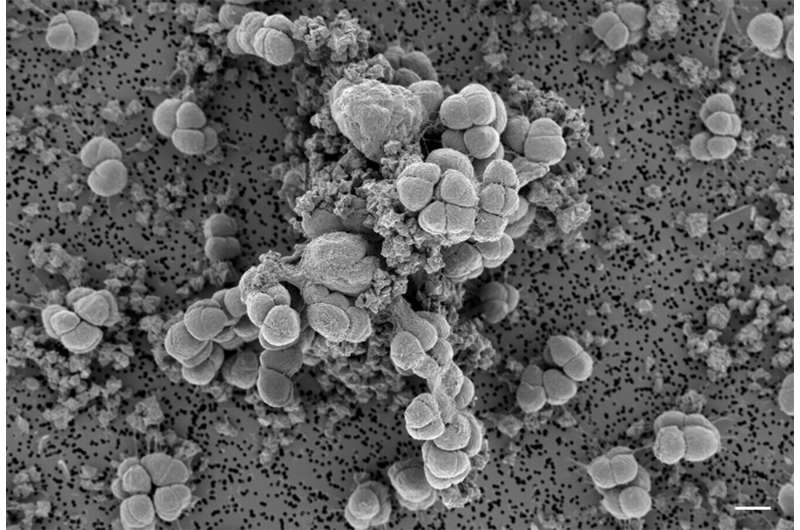This article has been reviewed according to Science X's editorial process and policies. Editors have highlighted the following attributes while ensuring the content's credibility:
fact-checked
peer-reviewed publication
trusted source
proofread
How ancient microbes extract important metals from their environment

A new publication from a Montana State University scientist deepens existing knowledge of an ancient life-form and how it continues unique ecological processes today. The paper, titled "Methanogens acquire and bioaccumulate nickel during reductive dissolution of nickelian pyrite," was published Oct. 13 in Applied and Environmental Microbiology.
The authors of the publication are professor Eric Boyd, former postdoctoral researcher Rachel Spietz and current postdoctoral researcher Devon Payne. Boyd's lab is housed in the Department of Microbiology and Cell Biology in MSU's College of Agriculture.
A key element of Boyd's research has been the exploration of microorganisms called methanogens, which are ancient life-forms that still exist today. Methanogens are unique because they don't use sunlight to power their metabolisms like most organisms do, and they are poisoned by oxygen. Instead, their metabolism uses chemicals from their environment, often breaking down rocks and minerals to do so. During the process, the cells produce methane, also known as natural gas.
Pinpointing exactly how methanogens do this could answer questions that reach back more than 3 billion years, said Boyd.
"Early Earth had no oxygen, and the atmosphere at that time contained a lot more methane and hydrogen," said Boyd. "That's largely due to these methanogens that react hydrogen with carbon dioxide to make methane. And all of a sudden, for reasons that aren't clear, methane started to decrease and oxygen started to increase. That was about 2.4 billion years ago. So, what happened?"
Boyd's new paper examines a specific type of methanogen that can isolate and bioaccumulate nickel from its surroundings, using minerals as a nutrient source to support growth. These findings help differentiate between two competing hypotheses about the reduction in atmospheric methane billions of years ago that was likely caused by a reduction in the methanogen population.
One hypothesis, Boyd said, is that changing environmental conditions led to more competition between methanogens and other organisms for environmental resources, causing a drop in methanogen population. The other theory suggests that changes in volcanic patterns on early Earth led to a decrease in available nickel, leading the methanogens to starve for this essential element.
However, the research contained in the new paper discovered that nickel-dependent methanogens need much less nickel to survive than previously thought. Their ability to accumulate nickel within themselves allows for survival even when nickel is scarce.
To make these observations, Boyd's research team grew methanogens in environments with varying amounts of nickel, observing how they responded to the different conditions. By measuring how much methane the microbes produced, they were able to estimate how well the methanogens were growing and surviving. Using a variety of spectroscopic techniques, the team could identify how much nickel the cells stored.
Boyd has been studying methanogens for nearly 20 years, a line of exploration he became interested in during his doctoral studies at MSU. For much of that time, his work has been supported by funding from NASA.
"When life originated, there was no photosynthesis. It was all mineral-based energy that was supporting life," he said. "And all of a sudden, we stumbled upon this discovery, which is essentially microbes taking minerals and reducing them in a way that was not supposed to be possible. Most of the time, the mineral gets oxidized and generates acidic mine drainage, but this process doesn't do that."
Better understanding of the "biomining" process could allow humans to develop mining technologies that have less environmental impact, said Boyd. The findings in the new paper represent another scientific step toward that possibility.
"There are three elements of this paper that I think are really special," said Boyd. "One is that we show that the cells can acquire nickel from a mineral, which hasn't been shown before. The second is that they can acquire it at extremely low concentrations. They don't need much, and that goes against conventional thought. The third is that they accumulate it, and that just makes sense. If there's something that you're very dependent on, and these bugs are so dependent on nickel, that they've found some way of ensuring that they've got plenty of it for the future."
While the scientific concepts and research process are extremely complex, Boyd said the larger implications of the work are quite simple, tying directly into the timeless questions of how Earth came to have a habitable environment for other life-forms and ultimately humans. As is often the case with research into the origin of life, new advancements raise new questions, leading to continued exploration.
"Understanding whatever it was that drove that transition away from a methane atmosphere is critical," he said. "If that transitional state didn't happen, you and I wouldn't be here to talk about it, because we need that oxygen in the atmosphere. In a sense, understanding the environmental past and how that changed and allowed for the evolution of complex life is central, not to just understanding how we got here, but also where we're going."
More information: Rachel L. Spietz et al, Methanogens acquire and bioaccumulate nickel during reductive dissolution of nickelian pyrite, Applied and Environmental Microbiology (2023). DOI: 10.1128/aem.00991-23
Journal information: Applied and Environmental Microbiology
Provided by Montana State University





















